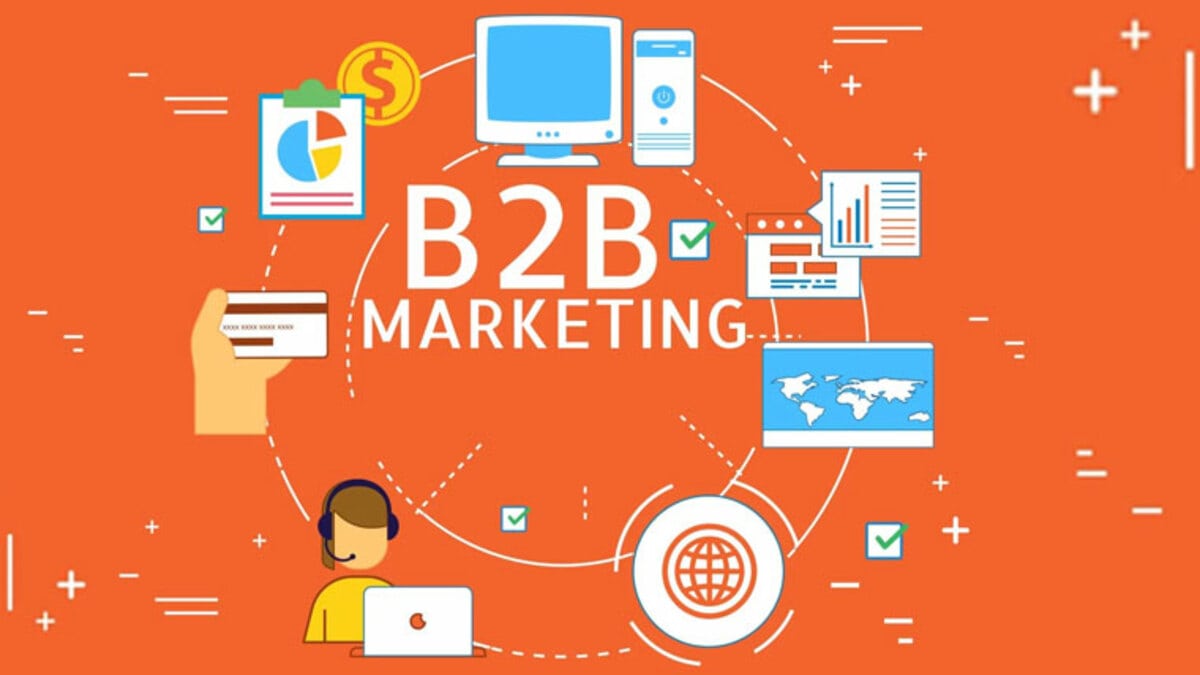Running a digital marketing campaign without a strategy in place is akin to exploring a new city without a GPS – you’re likely to take a lot of wrong turns, leading to frustration and an unnecessarily long route to get where you want to go.
When you’re planning a trip, you’ll likely start by creating an itinerary to ensure you’re making the most of your time and budget. The same goes for digital marketing, a marketing plan is necessary to increase effectiveness.

5 Key Components To Creating A Digital Marketing Strategy
Below are 5 key components to creating a winning digital marketing strategy. What follows are other components you may want to consider when creating a well-rounded, complete digital marketing strategy.
1. Goal Setting: Decide Where You Want To Go
When creating an itinerary, you have a destination in mind. When creating a digital marketing strategy, a destination is a set of defined marketing goals that you want your efforts to achieve. These marketing goals should be linked to the core goals of your business. For example, if your organization’s goal is to grow your client list by 20%, then your marketing goal should be to generate viable leads that will contribute to that success.
Whatever your goal is, you also need to make sure you measure your results. Maybe your goal is to increase the number of email subscribers. In this case, your key performance indicator (KPI) would be increased registrations.
2. Understanding Your Target Audience
When you travel, you know how important it is to understand how the locals communicate – you don’t want to look like a strange tourist. The same goes for digital marketing campaigns. This means understanding your target audience, demographics and the psychology of existing and new customers.
A potential buyer must go through several steps to reach the point of purchase and ideally become a long-term customer. The stages can vary, but they generally start with brand awareness and education, then move into the consideration stage, and finally end with a decision and sales conversion.
Effective Content Marketing
You can’t just write any content or follow the spray and pray method. You need to think strategically about what you’re writing about, what words you want to own, have an SEO keyword strategy in place, and think about ongoing content optimization.
3. Create An Ideal Customer Profile (ICP) And Buyer Persona
Meeting new people is one of the best parts of traveling! But it wouldn’t do any good to try to communicate with someone who doesn’t want to talk to you, would it? Maybe there’s a language barrier or they just don’t care who you are and what you do.
This also applies to marketing. As a digital marketer, you need to develop your buyer personas so you know exactly who you want to talk to, knowing that they will have a common interest in talking to you.
Keep in mind that the personas you create should be based on research. Have you proven success with a certain group of individuals? Great, focus on them! It is advantageous to be specific. Skip the stereotypes and look at factual insights with readily available tools like Facebook Audience Insights and Google Analytics.
You can begin to identify these individuals with basic background information such as job title and location. You also want to determine what this person wants, such as a solution to a specific problem (a problem your business can solve)! Next, determine the best way to approach this person, which leads us to step four.
4. Determine Effective Marketing Channels And Buying Stages
If you want to meet local beer connoisseurs, you can choose to visit a local pub. In turn, if you want to meet with decision makers in a particular industry, you need to choose where to find them, as well as what messages to use based on what stage of their buying journey they are at.
The awareness phase can be focused on education and establishing expertise while targeting decision makers in ideal client verticals. KPIs for this type of campaign can include reach, impressions, and engagement.
The consideration phase would influence and motivate by targeting those who have engaged in your awareness campaign with a promotion or value proposition. KPIs for this campaign can be related to lead generation.
The conversion phase would lead to a sale by redirecting past website visitors. A KPI for this campaign could be an appointment booked through a contact form or a contract/proposal signed.
By structuring your campaigns to meet the buyer where they are in their journey, you will move towards your marketing and business goals more strategically.
Keep buyer personas in mind. You have a good understanding of your audience and how they shop, but now you need to understand where to connect with them.
For example, if your buyer is a 35-year-old journalist who reads the news online, then Twitter may be the best channel for you to communicate with them.
Choosing the right digital channels will help you increase your ROI. There are more marketing platforms than ever before, so be strategic by identifying where your buyers are and connect with them through those channels.
5. Get Your Messaging Right
Let’s say you’re traveling solo and you pop into a local restaurant and sit at the bar. You see someone you want to talk to and know there is an art and etiquette to approaching them. The same goes for your marketing campaigns!
Craft your messages to resonate with whoever you’re trying to talk to. The voice and content of your campaign should speak to them in a way they understand. This concludes your research and planning from the previous steps.
If you’ve identified where they are in the sales funnel, you should know where to start the conversation. If they don’t know anything about you (exploration phase), start by clarifying your expertise and building trust.
If you’ve identified their buyer and you’re selling a service, you should know their pain points and tell them how you can solve their problems. If you are selling a product, you should know their interests.
When you take the time to get your messaging right, maybe even customize it, your audience will be much more receptive to what you have to offer.
Other Components Of A Digital Marketing Strategy
There are several other components to a solid digital marketing strategy. They cover basics like web design and SEO, along with more complex topics like CRM, CRO, data measurement, and analytics.
Web Design. SEO. Content Marketing.
Your company’s website is the main gateway that most (if not all) of your potential customers pass through before becoming actual customers. This means that it must be designed with efficiency, appeal and smoothness of user experience in mind. Without proper development of these components, inbound traffic will fail to convert or, even worse, leave without any meaningful engagement.
Basic web design concepts should be used when creating your website to ensure optimal results.
However, how the pages are set up and laid out is not enough if the content itself is not relevant and interesting. Careful attention should be paid to creating engaging material that visitors can connect with.
Here are some best practices for writing content for the web:
Make sure the introduction grabs people’s attention. Content should start with thoughts, questions or statements that shock, amuse, frighten, interest or inspire. If the reader is not engaged within the first few lines, chances are they will leave the page. Speaking of which…
Keep the main idea above the edge. The fold is the bottom line where most screens crop the initial display. Make sure your first (or at least second) paragraph briefly explains what the content is about. Readers want to know what they’re getting into before they move on.
Use multimedia. Images, videos and infographics are all valid tools to keep your content dynamic. Too much text on screen can be overwhelming for some readers and the goal is to keep them engaged.
Use your own voice. Every company – every brand – has a unique voice. You want people who visit your company’s website to know what yours is like, so make sure all your content matches that. If people engaging with the content sense that the tone is disingenuous or that something is off, even on some unconscious level, they are more likely to leave or react negatively.
Writing is by no means an exact science, but there is some common ground that most people can agree on. As a good reference point, the University of Maryland in Baltimore has put together a nice list of best practices to keep in mind when creating web content.
Once you have your website and content ready, it’s time to start thinking about ways to get your material found. The best (and cheapest) way to do this is to optimize your content to be found organically through search engines, including blogging, and align your bloggers with a high-traffic keyword strategy.
The internet powers search engines. It is estimated that Google alone processes over 3.5 billion queries every day. With staggering numbers like these, it’s no wonder that companies work hard to rank their content on these highly sought-after first results pages. With 71% of traffic left on this first page, it is essential to use proper search engine optimization (SEO) as part of your digital marketing strategy.
How Do You Optimize For Search Engine Results (SEO)?
Search engines work by quickly going through each individual indexed web page when a query is made, and then process the information using an algorithm that assigns a rank to each page based on a very specific set of criteria.
While the details of this process are under wraps, some parameters have been shown to affect the ranking, such as:
- Using keywords that clearly define the topic the content is addressing
- The number of links, both internal and external, that connect to and from each page
- Number of quality visits and engagement level of each page
For your content, this means you need to make sure it addresses each of these points so the page can rank higher and increase your chances of appearing on that coveted first page. This is what sets the content apart from all the other content on the same topic that saturates the searchable landscape.
By appearing on this first page, your company increases the likelihood of access to this content, which, as mentioned, is itself an important metric for search engines like Google when assigning rankings. This is called a click-through rate (CTR), which, as the name suggests, is the rate at which users who perform an inquiry click through to access your content. Like the number of backlinks to a page, this metric helps establish the credibility of your content and the authority of your website as a whole.
A good reference point for getting these basics—and a very wise instructional choice if you’re learning the ropes—is Moz’s renowned beginner’s guide to SEO.
Making these considerations part of your marketing strategy will ensure optimal results in driving organic traffic to your website, which is where the journey begins for those visitors, who will then have to decide how much to engage with what they find.
Customer Relationship Management (CRM) Tools.
Once visitors are drawn to the site and engage meaningfully with the content, they become leads. Leads are like little seeds that need to be nurtured and nurtured to blossom into customers. The best way to do this – and of course a key part of any digital marketing plan – is to have effective customer relationship management (CRM) tools in place. Many CRM tools can also improve your other marketing efforts, such as the way you do email marketing, some aspects of marketing automation, social media marketing, PPC (digital pay-per-click advertising), landing page creation, CTAs, and also tracking . offline activities.
A CRM service or software provides a number of tools for capturing contact information from those who deal with content and sorting it efficiently so that it can be quickly accessed by your sales, client relations or any client-facing department when needed.
How you get this information is entirely up to you, as it requires making changes to your website so that visitors will willingly pass it on. This is another point where conversion optimization comes into play, as it helps you determine which solution is best for that particular goal.
Is it a simple form that asks for contact information to sign up for a weekly newsletter? Is it a call-to-action button that offers access to download a free guide in exchange for an email address? Use data to determine which alternative works will be critical to growing your lead database.
Of course, this database is also important from the point of view of keeping existing customers in contact. By keeping track of those who have already become clients and using smart marketing tactics to maintain that interest, companies can increase their ROI for more purchases.
Make sure you discuss the available options with members of your client team – whether it’s a specific CRM system or a more complex and comprehensive platform where customer relationship management is actually one aspect of many – so you can choose because that decision will have an impact .
Analytics And Metrics: Making Decisions Based On Hard Data
Digital marketing strategy is all about removing speculation from the equation and focusing your tactics on accurate information or at least educated guesses and approximations. As your marketing efforts progress, your company will begin to acquire hard data that it will need to use to reshape, refocus, and redirect all efforts to optimize and maximize results.
Data can come from all types of sources. For example, social media platforms use their own set of performance-based metrics, which is certainly very useful. However, there is one tool that is absolutely remarkable when it comes to understanding the traffic that is coming to your website.
Enter Google Analytics. A Google Analytics tracking code installed on your website will collect information about all traffic, which pages it lands on, where it comes from – both source and medium – and how long it stays, how often it interacts with other pages or simply whether it leaves without further action among several other metrics. It will tell you which country the traffic is coming from, their demographics, and a few other stats about the type of people who are accessing your content.
When it comes to marketing, information like this is a rare commodity and Google Analytics is a gold mine.
The reason this information is vital is because it shows you how successful your marketing tactics are and how they can be improved. While closed sales and profit may be the ultimate measure of success for some companies, the metrics provided by these analytics can help increase customer acquisition rates simply by knowing what’s working and what’s not. Here you will learn which expenses to cut, which investment costs to cut and which to increase.
Analytics can be confusing for inexperienced users, but Google offers courses for both beginners and advanced users that even include Google Analytics certification.
This tool is indispensable for developing and gradually optimizing any digital marketing plan.
Paid Search And Social Media Ads
Every digital marketing strategy should include a portion of the budget for paid web marketing. While all the content and aspects of SEO certainly increase traffic, paid marketing actually offers a variety of insights that can be quite useful.
First and foremost, search engine ads and most social media offer instant data that can be used to gather information from potential customers, and since both of these platforms want people to continue to pay them to advertise, they offer opportunities for very precise remarketing—which is your company can target potential customers who have shown some form of interest but haven’t actively interacted with ads better suited to their interests.
While ads are usually more affordable and can be easier to manage, any paid search strategist will tell you that there is actually a science behind it all. Ads also need to be optimized, and best practices definitely come into consideration when building tactics. Learning the basics of paid search is extremely important if your business is to succeed.
The same principles apply to paid social media. The difference is that depending on how much budget you have allocated for that particular area, your company needs to be very careful and smart when making decisions.
It is very important to understand who your potential customers (or buyer personas) are. This will help you narrow down the list of platforms you may want to use. After all, each social media platform tends to have its own set of demographics, so knowing what your prospects are more likely to use will increase your success rate.
For reference, the folks at Hootsuite put together a list that offers a pretty nice overview of demographics by platform.
The type of message you will advertise is just as important to the type of platform, so be sure to plan what you will say or show with a clear understanding of what your potential customers are most likely to connect with.
Conversion Rate Optimization (CRO)
Traffic is not enough. You need to optimize your website for conversion so that these visitors become quality leads, meaning they engage with what they find and become leads or clients.
CRO is a very systematic solution that consists of – step by step – improving each page of your website to become the best possible version of itself. This is not improvisation or guesswork based on what you think will solve problems or increase engagement. It is a process of proven methods and powerful tools that provide hard data that can then be turned into precise changes that will significantly help the user experience.
What Steps Are Essential To Your Digital Marketing Strategy?
First you need to check your website. Using tools like Hotjar, you can evaluate page performance through heatmaps that reveal click and scroll engagement. This powerful service also provides anonymous site visit logs that show exactly what each visitor did, what they stopped reading, where their cursor moved and what they decided to click on.
This wealth of information can be used to determine which areas of the site are not attracting attention or engagement, which is in turn the kind of data that expert minds can use to define specific and actionable changes that will radically improve performance.
This is a complex process and it is often recommended that companies ensure their teams are knowledgeable in this area of work to reduce the level of testing and trial and error. If your company plans to use third-party digital marketing services, it’s a good idea to make sure it has the tools and know-how to increase conversion optimization rates.
Customer Lifetime Value (CLV): Prioritizing Clients
Customer Lifetime Value (CLV) is a metric that determines how valuable each client is to your company over the long term. The reason this particular information is useful is that it can be compared with the cost of acquisition to determine whether the current business model and practices are profitable or not, and to make future projections and estimates along those lines.
As part of your digital marketing strategy, this metric serves as the foundation from which your customer acquisition and retention tactics will grow. If your CLV for each client is less than what it cost your company to bring them in, then your entire promotional strategy needs to be restructured to reduce costs.
Calculating CLV shouldn’t be a daunting process if you understand the math and science behind it. If the whole process seems overwhelming to you, remember that neglecting this particular step in your marketing plan will have a negative impact on the quality of your future tactics.
Getting More Support
Digital marketing work can be very challenging as it is complex and diversified. In many cases, companies struggle with declining performance levels or even high employee turnover, all because they ignore the symptoms of a very real problem: burnout.
There are several ways to solve the problem of burnout among marketers, but the best and most cost-effective way is to simply outsource some of the workload.
Digital agencies provide a range of services that can help reduce the burden on overburdened and overwhelmed marketing departments, especially in mid-sized and large companies where the flow of various tasks is continuous.
The products offered by these help agencies can range from web development and design to all different aspects of digital marketing, so if they are to be included in the overall strategy, it is essential to sit down and research which areas the company needs real help with
Choosing the right marketing or web design agency is a delicate process that should not be taken lightly, as it will have an impact on your company’s overall digital performance.
Content Source: Xekera Systems
Do not forget to follow the company on social media:
Twitter | LinkedIn | Facebook
Recent Posts
-

-
 How to Turn Hardware Design/Development Process Into SuccessAUGUST 22, 2022
How to Turn Hardware Design/Development Process Into SuccessAUGUST 22, 2022 -
 What is Single Page Application. A Complete GuideAUGUST 19, 2022
What is Single Page Application. A Complete GuideAUGUST 19, 2022 -
 8 Most Popular Backend Frameworks for Web App DevelopmentAUGUST 18, 2022
8 Most Popular Backend Frameworks for Web App DevelopmentAUGUST 18, 2022

What is Social Media Marketing for B2B Companies?
Social media marketing is any marketing that takes place in a social media environment. Usually, that means posting content to your company account to get fans involved with your business. The purpose of B2B companies’ social media platform is to attract your favorite people to social media and familiarize yourself with your business. Since people often […]

PCB Assembly and Soldering Techniques you should know
Key Takeaways The combination of PCB and soda completes the construction of the circuit by picking, placing, and assembling the parts on the board. In through-hole technology, the leading or pinned electronic components are sold on board to form a circuit. Wave soldering is a common method used in THT and SMT PCBA. Printed circuit […]
Today's Top Posts
-
 16 access_time
16 access_timeGroup Tours Kimberley: Popular Locations You Must Visit
-
 16 access_time
16 access_timeThe Reason Why Everyone Is Obsessingabout Cherry Edible
-
 15 access_time
15 access_timeA Top-of-the-line Cryptocurrency Exchange Script Solution for Your Startup
-
 15 access_time
15 access_timePremium Quality shirts & dhoti Visit Minister White Retail Store
-
 14 access_time
14 access_timeReasons to Invest in Islamabad Pearl Enclave
-
 14 access_time
14 access_time5 Tips To Selecting The Very Best Solar powered Company
-
 13 access_time
13 access_timeIs JFK Airport Car Service the Best Way to Travel Comfortably?
-
 13 access_time
13 access_timeTracking Triumph: Mastering Work Time Tracking for Enhanced Efficiency
-
 13 access_time
13 access_timeSilver Bracelets for Women A Timeless and Elegant Accessory
-
 13 access_time
13 access_timeLDV Vehicles














